Toyota Camry vs Kia Niro EV – Differences & Prices Compared
Compare performance, trunk space, efficiency, and price at a glance.
Find out now which car suits you better – the Toyota Camry or the Kia Niro EV?
The Toyota Camry (Sedan) comes with a Hybrid engine and Automatic transmission. In comparison, the Kia Niro EV (SUV) features a Electric engine and Automatic transmission.
If you're looking for more power, decide whether the 232 HP of the Toyota Camry or the 201 HP of the Kia Niro EV better fits your needs.
The Toyota Camry offers a fuel efficiency of 53 mpg, compared to for the Kia Niro EV.
Price-wise, the Toyota Camry starts at 28700 $, while the Kia Niro EV is available from 39600 $. Compare all details and see which model fits your lifestyle best!
In the realm of midsize sedans, the Toyota Camry continues to impress with its blend of reliability, comfort, and sleek design, making it a perennial favorite among drivers seeking a classic gasoline-powered experience. On the other hand, the Kia Niro EV stands out in the electric vehicle segment with its eco-friendly credentials, offering an impressive range on a single charge and a modern, tech-forward interior. While the Camry appeals to traditionalists with its tried-and-true formula, the Niro EV attracts those looking to embrace the future of driving without sacrificing practicality or comfort.
Toyota Camry
The Toyota Camry has long been a staple in the midsize sedan market, known for its reliability and comfort. With its sleek design and smooth ride, the Camry continues to appeal to a wide range of drivers looking for a practical yet stylish vehicle. Advanced safety features and a comfortable interior make it a popular choice for families and commuters alike.
detailsKia Niro EV
The Kia Niro EV makes an impression with its sleek, modern design and spacious interior, offering a comfortable and practical ride. Its range is suitable for both daily commutes and longer journeys, making it a versatile choice for eco-conscious drivers. Smooth handling and responsive performance add to the Niro EV's appeal, providing an enjoyable driving experience.
details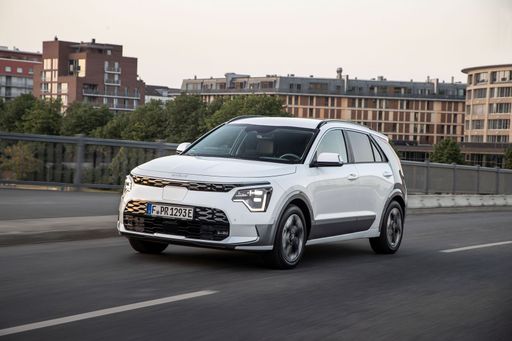 @ press.kia.com
@ press.kia.com
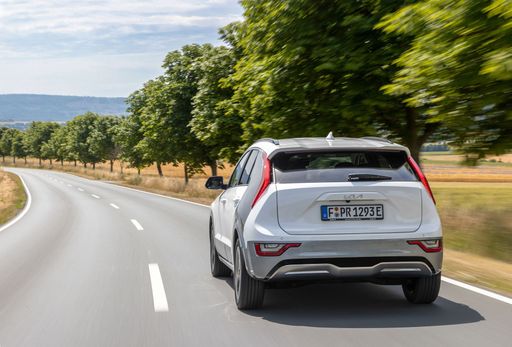 @ press.kia.com
@ press.kia.com
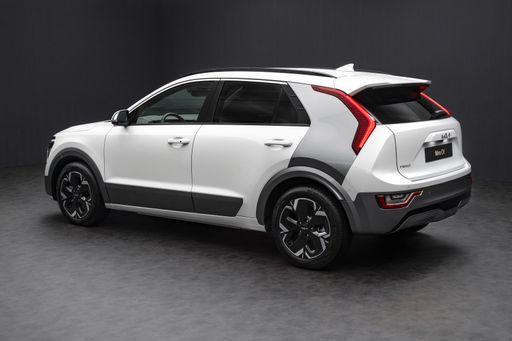 @ press.kia.com
@ press.kia.com
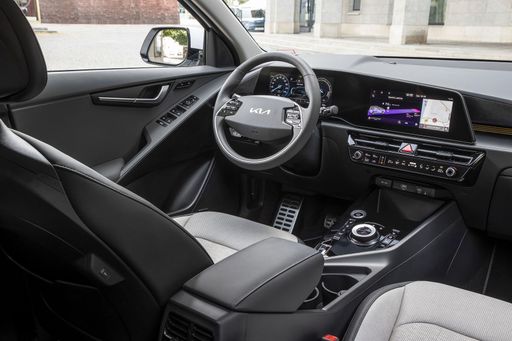 @ press.kia.com
@ press.kia.com
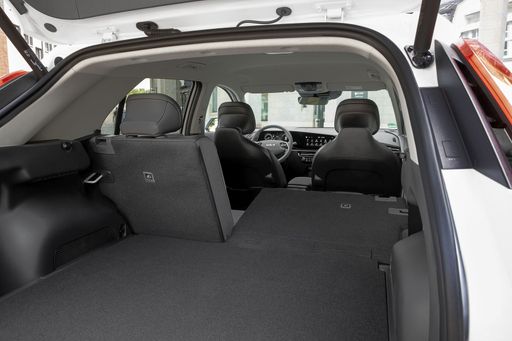 @ press.kia.com
@ press.kia.com
Battle of the Ecos: Toyota Camry vs. Kia Niro EV
In an ever-evolving automotive landscape, the desire for eco-friendly driving solutions continues to mount. As consumers balance between sustainable innovation and practical day-to-day performance, two significant contenders stand out: the long-lauded Toyota Camry Hybrid and the avant-garde Kia Niro EV. Here, we delve into their defining characteristics, pitting Toyota’s hybrid staple against Kia's fully electric offering.
Power and Performance
The cornerstone of any vehicle lies in its engine performance, and both the Camry and the Niro EV bring unique attributes to the table. The Toyota Camry Hybrid, available in two model years (2024 and 2025), boasts a hybrid powertrain with engine outputs varying from 208 to 232 horsepower and a torque of 163 lb-ft. Its engine displacement is a refined 2.5L, seamlessly combined with an automatic transmission. Power is distributed either through front-wheel drive or the optional all-wheel drive. This flexibility allows the Camry Hybrid to maintain an edge in various driving conditions.
On the electric frontier, the Kia Niro EV, with its latest 2024 iteration, offers a reliable electric motor, presenting 201 horsepower and a robust torque of 188 lb-ft. Unlike hybrid models, the Niro EV's instant torque delivery assures swift and smooth acceleration, complemented by a single-speed electric transmission aimed at efficiency and simplicity.
Sustainability and Economy
The environmental credentials of both contenders are noteworthy. Toyota's Camry Hybrid achieves an admirable fuel economy with city estimates ranging from 44 to 53 mpg and highway efficiencies spanning 43 to an impressive 53 mpg. The fuel tank capacity of 13 to 13.2 gallons supports an extended driving range, essential for those reluctant to invest time and energy at the pump.
Conversely, the Kia Niro EV circumvents traditional fuel reliance entirely. Its electric capabilities mean zero emissions, with monetary savings amplified by reduced dependency on gasoline. While electric range specifics aren't disclosed here, the EV's sustainability advantages are evident. Charging infrastructure advancements further supplement the Niro EV’s viability as a sustainable commute partner.
Dimensions and Design
Diverging in form factor, the Camry presents itself as a classic sedan, stretching between 192.1 to 193.5 inches in length and standing at 56 inches tall. It carries a trunk volume of 15.1 cubic feet, sufficient for everyday storage needs. The Camry's design respects aerodynamic efficacy and passenger comfort, with curb weights spanning 3,450 to 3,682 lbs.
The Kia Niro EV opts for an SUV body type, compact yet practical. Its dimensions are more succinct, residing at 174 inches long, 71.9 inches wide, and 61 inches high, with a curb weight of 3,721 lbs. The Niro EV's design speaks to the spirit of modern utility, offering a spacious, high-riding position optimal for visibility and ingress.
In Conclusion
The decision between Toyota's hybrid expertise and Kia's electric innovation depends largely on personal preference and driving priorities. The Toyota Camry Hybrid continues to impress with its fuel efficiency and flexibility across varied driving landscapes, remaining a paragon of hybrid reliability. On the other hand, the Kia Niro EV appeals to the eco-conscious with its zero-emission commitment and instant electric performance.
Both vehicles exemplify the strides automakers are taking towards greener solutions, each forging its path with distinct advantages that redefine the meaning of sustainable driving.

|
|
|
|
|
Costs and Consumption |
|
|---|---|
|
Price
28700 - 36400 $
|
Price
39600 - 44600 $
|
|
FuelEconomy City
44 - 53 mpg
|
FuelEconomy City
-
|
|
FuelEconomy Hwy
43 - 53 MPG
|
FuelEconomy Hwy
-
|
|
Electric Range
-
|
Electric Range
-
|
|
Battery Capacity
-
|
Battery Capacity
-
|
|
Fuel tank capacity
13 - 13.2 gal
|
Fuel tank capacity
-
|
Dimensions and Body |
|
|---|---|
|
Body Type
Sedan
|
Body Type
SUV
|
|
Seats
5
|
Seats
5
|
|
Doors
-
|
Doors
-
|
|
Curb weight
3450 - 3682 lbs
|
Curb weight
3721 lbs
|
|
Trunk Volume
15.10 cu. ft.
|
Trunk Volume
-
|
|
Length
192.1 - 193.5 in.
|
Length
174 in.
|
|
Width
72.40 in.
|
Width
71.90 in.
|
|
Height
56 in.
|
Height
61 in.
|
Engine and Performance |
|
|---|---|
|
Engine Type
Hybrid
|
Engine Type
Electric
|
|
Transmission
Automatic
|
Transmission
Automatic
|
|
Drive Type
Front Wheel, All Wheel
|
Drive Type
Front Wheel
|
|
Power HP
208 - 232 HP
|
Power HP
201 HP
|
|
Torque
163 lb-ft
|
Torque
188 lb-ft
|
|
Number of Cylinders
-
|
Number of Cylinders
-
|
|
Engine Displacement
2.50 L
|
Engine Displacement
-
|
|
Gears
-
|
Gears
-
|
General |
|
|---|---|
|
Model Year
2024 - 2025
|
Model Year
2024
|
|
Brand
Toyota
|
Brand
Kia
|
Toyota Camry
A Refined Legacy: The Current Toyota Camry
The Toyota Camry has consistently been a symbol of reliability and innovation in the automotive world. Now, the latest models continue this proud tradition, boasting significant improvements in efficiency, performance, and technology. Available in multiple configurations, the Camry offers a choice to suit a variety of drivers' preferences, with options for both hybrid automatic front-wheel and all-wheel drivetrains.
Under the Hood: Power and Efficiency
At the heart of the Toyota Camry is a robust hybrid engine, designed to marry efficiency with power. Current iterations are equipped with a 2.5L engine, paired with hybrid technology, yielding horsepower options of 208, 225, and 232 HP. The torque stands at a formidable 163 lb-ft, ensuring a responsive and engaging driving experience.
The fuel economy is another highlight, with city mileage ranging from 44 to 53 mpg depending on the variant, while highway performance delivers between 43 and 53 mpg. These figures reinforce the Camry's status as an eco-friendly choice in the sedan category, perfect for drivers seeking to minimize their environmental footprint.
Design: Spacious and Thoughtful
The Toyota Camry continues to embrace its sedan identity with an elegant design that prioritizes both aesthetics and functionality. With dimensions measuring around 193.5 inches in length, 72.4 inches in width, and a height of 56 inches, the Camry offers a spacious interior that comfortably accommodates up to five passengers.
Cargo space is not overlooked, with a trunk volume of 15.1 cubic feet providing ample room for luggage or groceries. Additionally, the sedan's curb weight, ranging from 3,450 lbs to 3,682 lbs, allows for a sturdy yet comfortable ride even on the longest of journeys.
Advanced Features and Innovations
Technological advancements are hallmarks of the current Camry models, ensuring a more connected and joyful drive. The automatic transmission seamlessly integrates with the hybrid system to provide smooth transitions and optimal fuel efficiency. In addition to this, Toyota has focused on safety and driver assistance features to enhance the driving experience, offering state-of-the-art systems that help ensure the safety of all occupants.
The Toyota Camry is also equipped with a fuel tank capacity of up to 13.2 gallons, which ensures fewer stops at the pump, allowing for extended driving ranges between refuels. This strategic design enhances the vehicle's practicality for long commutes or road trips.
Conclusion: A Comprehensive Automotive Solution
Overall, the Toyota Camry continues to excel in delivering a balanced automotive experience that combines power, efficiency, and advanced features in a sleek sedan package. Whether you are navigating city streets or exploring open highways, the Camry is well-equipped to meet the modern driver's needs, consistently proving why it remains a popular choice on the market.
Kia Niro EV
The Futuristic Drive: Exploring the Kia Niro EV
The Kia Niro EV blends style, efficiency, and technological innovation, offering a compelling package for environmentally conscious drivers. With its sleek design, outstanding range, and advanced features, the Niro EV stands as a strong contender in the rapidly growing electric vehicle market.
Performance and Efficiency
At the heart of the Kia Niro EV's performance is its powerful electric motor. The Niro EV boasts a robust 201 horsepower and 291 lb-ft of torque, ensuring a lively and responsive driving experience. This dynamic performance is complemented by a swift 0-60 mph time of approximately 7.8 seconds, making city drives and highway merges seamlessly effortless.
One of the most impressive aspects of the Niro EV is its range. With an EPA-rated range of up to 239 miles on a single charge, drivers can enjoy extended journeys without the constant need for recharging. This is made possible by a 64 kWh lithium-ion polymer battery, which can be replenished to 80% capacity in approximately 54 minutes using a DC fast charger.
Cutting-Edge Technology
The Kia Niro EV is packed with technology that enhances both convenience and safety. The 10.25-inch color touchscreen display is the centerpiece of its infotainment system, offering seamless integration with Apple CarPlay and Android Auto. This setup ensures that essential information like navigation, media, and calls are always within easy reach, allowing for a connected and intuitive driving experience.
Safety is another area where the Niro EV excels. It is loaded with advanced driver-assistance systems including Forward Collision-Avoidance Assist, Smart Cruise Control with Stop & Go, and Lane Keeping Assist. These features work in harmony to provide peace of mind and added protection on the road.
Innovative Design
The Kia Niro EV embodies an eco-friendly yet modern design language, distinguishing itself with unique styling cues that highlight its electric nature. Its aerodynamic lines and bold profile not only enhance the vehicle’s aesthetic appeal but also contribute to its impressive energy efficiency.
The interior of the Niro EV offers a spacious and comfortable environment, characterized by high-quality materials and thoughtful ergonomics. The lack of a traditional transmission tunnel provides more room for passengers and creates a sense of openness in the cabin, enhancing the overall comfort and enjoyment of the drive.
Conclusion: A New Standard in Electric Driving
The Kia Niro EV sets a new benchmark for what an electric crossover can offer. With its blend of potent performance, impressive range, and state-of-the-art features, it is designed to meet the demands of modern drivers seeking sustainable yet versatile mobility solutions. For those looking to make an effortless transition to electric, the Niro EV emerges as a top choice that doesn't compromise on style, functionality, or technology.
What is the price of the Toyota Camry?
Starting from 28700 $.
The prices and data displayed are estimates based on USA list prices and may vary by country. This information is not legally binding.
